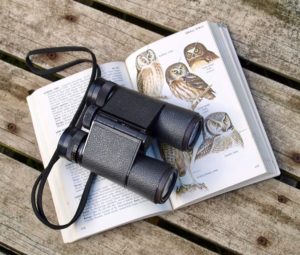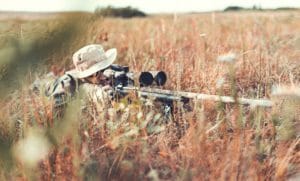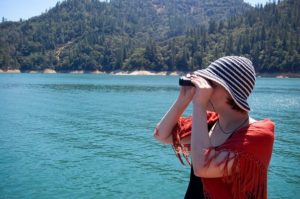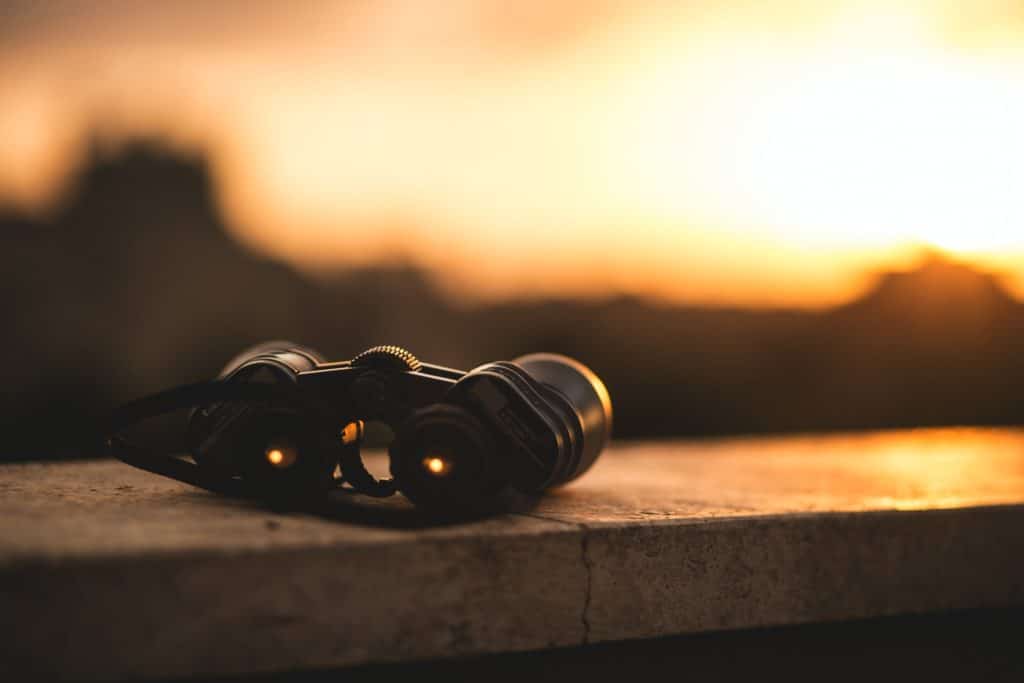All sailors and boating enthusiasts know that when it comes to sailing waters, whether for fun or even for work, a good set of marine binoculars can be all that is standing between you and disaster.
Sea, and even lake, conditions can be very dynamic; hence a good set of boating binoculars is essential.
However, sifting through what the market has to offer to find a suitable pair of boating binoculars can be confusing even for the seasoned sailor.
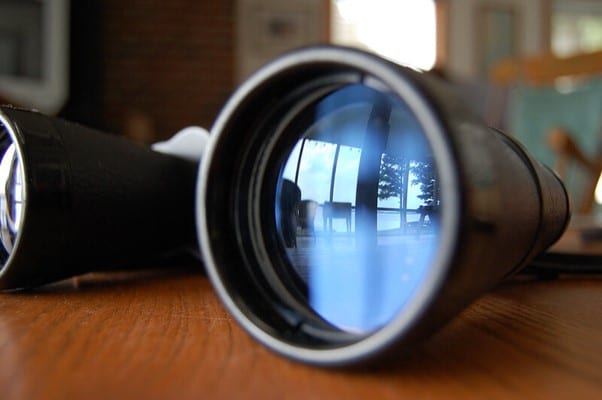
This article takes you beyond the jargon and recommends our top picks for the best binoculars for boating. We also go over all you will need to know to narrow down the choices in the market.
However, if you want to skip straight to our top pick, we recommend the Steiner Navigator Pro 7×50 Marine Binoculars.
Here is the full list of our top recommendations of the best boating binoculars:
- Steiner Navigator Pro 7×50 Marine Binoculars – Best Overall
- Bushnell H2O Marine Binoculars – Best Value
- Barska Deep Sea 7×50 Waterproof Marine Binoculars – Best Budget Option
- Nikon OceanPro 7×50 Boating Binoculars – Best Extra Features
- Steiner MM1050 Military-Marine 10×50 Tactical Binocular – Most Resistant
- Hooway 7×50 Marine Binoculars – Easiest to Carry
Features to Consider Before Choosing Boating Binoculars
A pair of boating binoculars is an essential tool to use at sea to navigate or to check for hazards or other vessels.
Additionally, they can make your boating experience much more enjoyable by allowing you to closely view dolphins, whales, turtles, seals or seabirds.
Of course, you want the best product you can get your hands on, so when it comes to understanding binoculars, there are essential features you will need to remember.
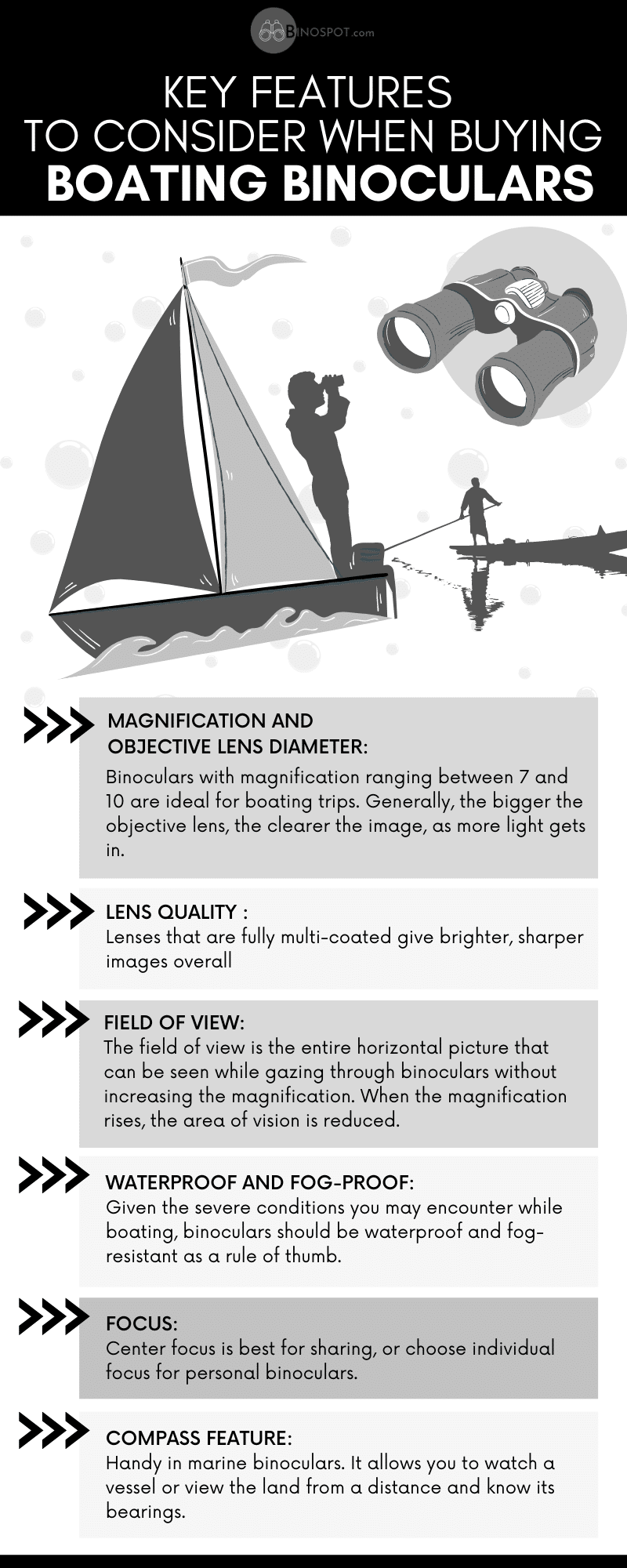
Magnification and Objective Lens Diameter
We cannot stress this feature enough; when you are at sea, you need to see what is ahead far in advance. Because of this, the correct magnification in your binoculars is the most integral feature.
Binoculars are typically classified using numbers, for instance, 7×50 or 10×50. The first number on your binoculars represents the magnification—a magnification of between 7 and 10 is ideal.
Any seasoned sailor knows that as magnification increases, it becomes challenging to maintain an item in clear focus. The high magnification reduces the field of view causing the image to blur at the slightest of movement. Additionally, brightness diminishes.
With magnifications higher than 10 it is difficult to hold a steady image and blurring can easily occur without the use of a tripod.
The second number on your binoculars, which comes after the magnification and is usually bigger, denotes the objective lens’ diameter, in millimeters.
The bigger the number, the bigger the front lens of the binoculars, and the more light is captured. This feature is particularly critical in poor light at sea. The ideal size is between 40 and 50 millimeters. If you go any higher than this, the binoculars can become too bulky and heavy to carry.
So, the recommended magnification and objective lens diameter setting on your marine binoculars should, ideally, be 7×50.
Lens Quality
The binocular coating type applied determines the lens quality. This is because the coating minimizes the amount of light reflected and allows maximum light to go through.
Coated lenses offer more clarity and sharper images overall. If you buy a cheap pair of binoculars, you’ll notice the images will be dull as you’ll have lost over 30% of light. So what coating types are ideal for the best boating experience?
- Coated means that there is just one anti-reflective coating on at least one lens.
- Fully coated means that the coating is on the objective lens, ocular lens, and prism.
- Multi-coated means that there are multiple layers on more than one lens.
- Fully multi-coated means that the objective lens, ocular lens, and prism have multiple coatings. A pair with this coating will give you high-quality images.
Although the level of lens coating does not guarantee the best quality, it improves the overall performance of the binoculars.
Lenses with multi-coatings reduce light loss effectively, resulting in a better image. Without the chemical coating, each lens may lose up to 5 percent of the light passing through it.
Field of View
The field of view is another important feature you need to consider when choosing a pair of marine binoculars. The field of view is the entire horizontal picture that can be seen while gazing through binoculars without increasing the magnification.
It is important to note that the magnification and field of view are inversely related. When the magnification rises, the area of vision of the marine binoculars is smaller, resulting in a narrower picture. It is necessary to select binoculars with the broadest field of view possible.
Waterproof and Fog-Proof
Waterproof and fog-proof features should go without saying, primarily because of the conditions at sea.
The weather is dynamic, and waves can be unrelenting from time to time. Given the severe conditions you may encounter while boating, peering through a foggy lens your judgment and distance perception can become incredibly impaired.
Therefore, any binoculars you use on water should be waterproof and fog-resistant as a rule of thumb.
Most high-quality marine binoculars are fog-proofed by filling them with Nitrogen or Argon gas and sealing all openings with O-rings. The gas is put in the binoculars to prevent moisture from penetrating, making the tubes invulnerable to the elements at sea.
The gas also ensures that no corrosion or fungus occurs in your binoculars when inadequately stored, e.g., when kept in a wet area without any protective measures.
Manufacturers also use anti-fog finishings (a water-repellant mixture) to prevent water droplets from forming on the outer lenses.
Focus
Focus refers to the adjustability feature for your binoculars’ magnification. There are usually two main configurations produced for marine binoculars – center focus or individual focus.
If you plan to share your binoculars between different members of a crew, the center focus binoculars are ideal because the user can quickly and simultaneously adjust the focus on both eyepieces.
Each crew member can easily adjust the focus according to their visual needs.
The individual eyepiece focus binoculars are ideal for your personal binoculars use. If you don’t have 20/20 vision you can focus each tube individually to suit your sight.
Eye Relief
The distance between the outer surface of the eyepiece lens and the place where the exit pupil is formed is known as eye relief.
You can see the entire field of vision without vignetting while looking through binoculars with proper eye relief. Binoculars with a longer eye relief should be used by people who wear glasses.
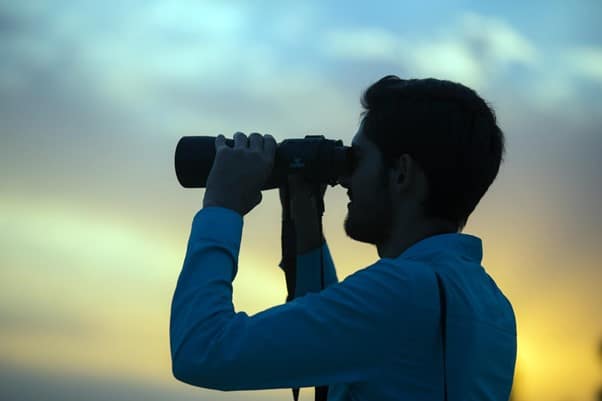
Compass Feature
A compass is incorporated as an extra feature in some marine binoculars. It allows you to watch a vessel from a distance to know its bearings. The compass comes as an inbuilt feature so that while looking through the binoculars, a superimposed compass is right below the image.
Our Recommendations for the Best Binoculars for Boating
Steiner Navigator Pro 7×50 Marine Binoculars — Best Overall
At the top of our list and our best overall recommendation is the Steiner Navigator Pro 7×50 Marine Binoculars.
Boating binoculars don’t get any better than this pair. The Steiner Navigator Pro binoculars come with a polycarbonate housing that makes them shockproof and able to float on water. They’re lightweight, weighing just slightly above half a kilogram.
The Steiner Navigator Pro 7×50 Marine Binoculars can be magnified up to seven times. This gives you access to a field of vision that spans 370 feet, which is a plus for viewing otters, humpback whales, eagles, etc.
The major con we can find with this pair of binoculars is that the price is relatively high, but such is the cost of quality.
Pros:
- Superb optics give a bright picture even in low light.
- They have a sports-auto focus system that keeps all images perfectly in focus.
- They come with an in-built compass option.
- They have a 7x magnification.
- They are shock-resistant, thanks to the rubber casing.
- Floats in water perfect for sea conditions.
Cons:
- They are expensive.
- They are pretty heavy for an all-day kind of use, weighing exactly 0.8kgs.
- The in-built compass version is even costlier.
Bushnell H2O Marine Binocular — Best Value
Coming in at a close second after our best pick is the Bushnell H2O Marine Binocular. This is our best value recommendation, a suitable choice for the veteran seafarer and the novice beginner.
The Bushnell H2O Marine Binocular is a durable and affordable option that offers users value for their money. The pair comes with numerous high-end features suitable for use at sea.
Firstly, it has a rubberized outer coating making it fit enough to stand up against any trauma and the rigors of sea life and the elements. In addition, it is purged with Nitrogen making it resistant to moisture penetration from water and fog. This means that these binoculars are safe to use at sea.
The binocular uses a 7x magnification capacity lens that is hermetically sealed to keep the housing as protective as possible. It also uses the Porro prism system with Bak-4 prism glass, and this provides fantastic image clarity and range in open seas, cementing its spot as our best value recommendation.
Pros:
- It is pretty affordable for a high-end binocular.
- Bak-4 prism glass for quality optics.
- Durable high-quality rubber exterior.
- It is Nitrogen purged, making it invulnerable to fogging and corrosion from wet conditions, perfect for conditions at sea.
- It is hermetically sealed, making its housing as protective as possible to last longer.
Cons:
- The focus feature on this specific model is not as good as some of its counterparts. It isn’t easy to focus the lens on this binocular, meaning it is possible to miss spotting something at sea while adjusting it.
- The rubber exterior makes it very uncomfortable to hold over a long period.
Steiner MM1050 Military-Marine 10×50 Tactical Binocular — Most Resistant
The Steiner MM1050 Military-Marine 10×50 Tactical Binocular is our most resistant binocular recommendation for several reasons. It is the perfect combination of function and durability, making it efficient to use in even the harshest weather conditions.
As the name suggests, the Steiner MM1050 Military-Marine 10×50 Tactical Binocular was designed for the military, so you can bet on its quality. These are a compact pair of binoculars, framed in a durable rubber-coated body sure to withstand the wear and tear of the ocean during its tenure.
The manufacturers have even been heard to dare buyers to back over them with their cars and witness no damage to them. We do not recommend you take them on their offer; however, we do sign off on the level of their hardiness.
The rubber exterior houses two high-quality lenses with a magnification of up to 10x. The extreme moisture that comes with boating is not anything to worry about with this binocular, mainly because its tubes are infused with Nitrogen making it fog-resistant and rain water-resistant.
Pros:
- It is compact, durable, and hardy because of its rubbery exterior.
- It has a powerful 10x magnification lens.
- It is Nitrogen purged, making it resistant to fog and able to be used even in the rain.
Cons:
- It is military-grade, hence costly for regular use.
Barska Deep Sea 7×50 Waterproof Marine Binoculars — Budget Option
The Barska Deep Sea 7×50 Waterproof Marine Binoculars come with a moderate price tag, making them our budget-friendly recommendation. Incorporating a range of unique features, they can hold their own against market competitors.
If you’re looking for binoculars with compass features, these come with an in-built rangefinder and an inner compass that illuminates, making it easy to keep track of things or get your bearings while you are out at sea in the dark.
The lens has a special coating that makes them waterproof and they can magnify objects up to 7x, which is as powerful as their market counterparts. The more refined or experienced seafarer might prefer binoculars with a bit more spank, but this brand is right up your alley for beginners.
Pros:
- Affordable pricing while not sacrificing the feature quality.
- They are waterproof and fog-resistant due to a special lens coating.
- They have a powerful lens magnification of up to 7x.
- They have an internal rangefinder and an illuminated compass suitable for all-weather situations as well as night voyages.
Cons:
- Compared to their high-end counterparts, these binoculars are not as clear.
- They have a flimsy outer body not suitable for day-to-day use.
- The focus knob is difficult to handle and comes off easily.
- They are uncomfortable to hold over an extended period.
Nikon OceanPro 7×50 Boating Binoculars — Best Extra Features
If you know the brand Nikon, you have a good idea why these binoculars are listed on our best extra features recommendation.
The Nikon OceanPro 7×50 Boating Binoculars go all out in their optics. The lens enjoys a 7x magnification capacity and a 50mm objective lens. Additionally, the lens features a BAK-4 Porro prism for bright, crisp pictures throughout the entire field of view.
The binoculars are nitrogen-charged inside to prevent fogging on the internal lens surface, making them ideal for use at sea. An extra feature is that the lenses are multi-coated with a unique solution that negates shadows and optimizes colors for a clear viewing experience.
Pros:
- High-quality lens coating for clearer viewing.
- Powerful 7x magnification capacity lens.
- Fogproof and waterproof features are ideal for use at sea.
- They are Nitrogen purged, making the internal lenses corrosion-free.
Cons:
- They are expensive.
- It is difficult to adjust the focus on these binoculars.
Hooway 7×50 Military Marine Binoculars — Easiest to Carry
The last on our list but certainly not the least of our recommendations is the Hooway 7×50 Military Marine Binoculars. These compact binoculars are our recommendation for the easiest binoculars to carry and a befitting notable mention.
These binoculars are in the same league as their market counterparts as far as lenses are concerned. They also come with rubberized body armor that makes them highly durable and provides a sturdy waterproof outer body design.
They have a powerful 7x magnification and even feature a convenient compass designed to help you identify the location and range of objects at sea. The selling point, however, is the compact size. These lightweight binoculars can easily be tossed into a traveling pouch.
Pros:
- They are more affordable than similar products in the market.
- They have a powerful 7x lens magnification.
- They come with an in-built compass and rangefinder.
- Compact, lightweight, and easy to carry on your person.
Cons:
- The overall viewing quality is not exceptional. While you get the full 7x magnification, the image will not be as sharp as with other models.
- Hard to adjust the focus of the lenses.
- Uncomfortable to hold over a prolonged period.
Frequently Asked Questions
What Is the Main Difference Between Roof Prism and Porro Prism Binoculars?
Binoculars come in a wide range of specifics and features. However, they come in two main shapes or styles: roof prism and Porro prism.
Roof-prism binoculars are usually smaller and have a straight-barrel light path. Porro-prisms are different in style, with an off-set design that makes the overall shape of the binoculars more triangular.
As far as quality goes, there are very few differences between porro and roof prisms when comparing image quality. However, roof-prism designs are generally smaller and often more expensive due to a more complicated manufacturing process.
Can I Take My Binoculars Apart to Clean Them?
The short answer to this question is absolutely not!
Most binoculars are filled with Nitrogen or Argon to prevent fogging and corrosion of internal parts. Taking them apart even in the least will compromise this feature. Also, the level of expertise required to put the binoculars together correctly is pretty high; hence, you risk destroying your binoculars if you take them apart yourself.
This is an expert job that should only be carried out by professionals.
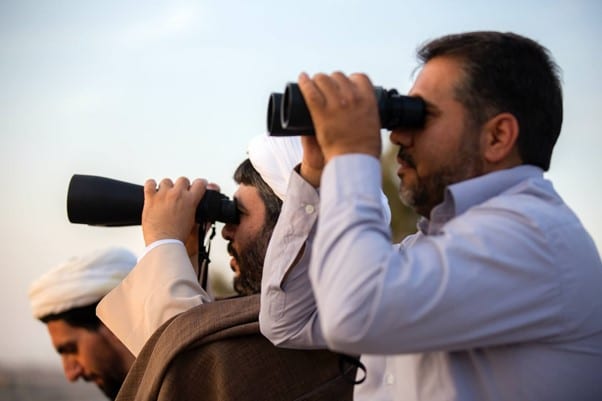
What Type of Warranty Is Ideal for Boating Binoculars?
Hardly ever considered, we recommend you select binoculars with a lifetime warranty. Like with other gadgets, the shorter the warranty, the riskier it is for you. This means that should a fault occur after the duration, the repair costs will fall squarely on you.
Binoculars are very fragile and intricate equipment, and if they get out of calibration or a fault develops due to a manufacturing defect, you will definitely need support. Some companies provide customers with generous lifetime warranties, while others don’t.
The warranties are great if you can get them because not only does it guarantee you the help should you need it, but it also means that the manufacturer has confidence in the quality of the equipment.
What Does FMC Mean on the Side of Binoculars?
This abbreviation is common on binoculars and is an acronym. In full, FMC stands for Fully Multi-Coated optics. It refers to the lens, which offers the most outstanding protection against glare and reflection from the water.
Why Are Binoculars So Expensive?
Most highly-priced binoculars are so because they are built with expensive optics, high standards, and by highly skilled technicians using the latest technology. Also, they utilize only the finest quality materials and components to increase user experience.
The type of lens coating used also plays a significant role in affecting the price of binoculars.
A lower quality may lose as much as 35 percent of the light getting into the objective lens, but a high-end design may lose less than 5 percent. Therefore, fully multi-coated lenses will to be more expensive than single-coated lenses.
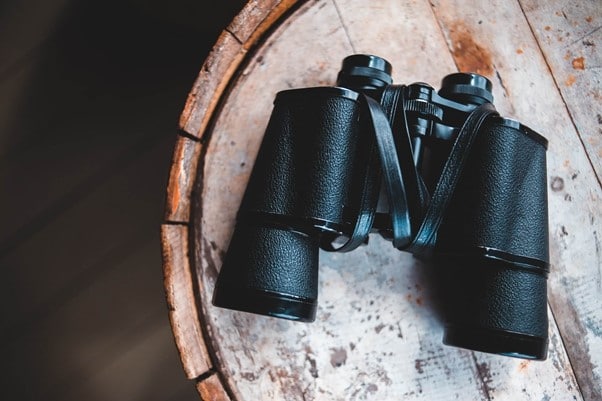
Conclusion
In the end, very few binoculars top our best recommendation, the Steiner Navigator Pro 7×50 Marine Binoculars. This Steiner model is durable, high-quality, and perfect for all kinds of ocean viewing activities and will give you a fulfilling experience.
If you cannot make the price, not to worry, our other recommendations are note-worthy in themselves for their price range.
Depending on your specific needs and your budget, any of our top picks will come in handy.









